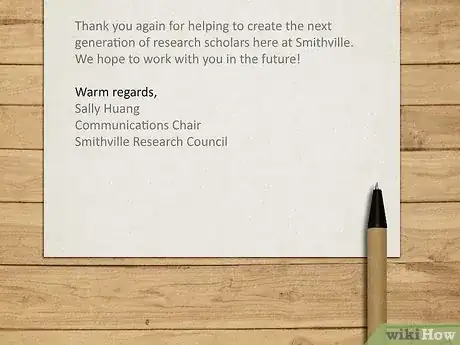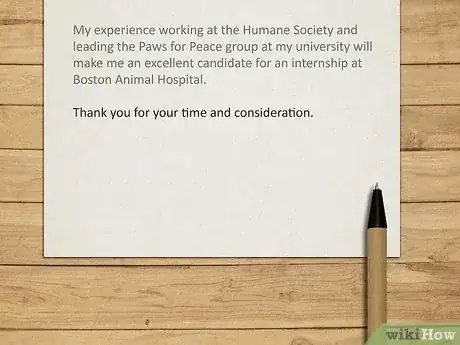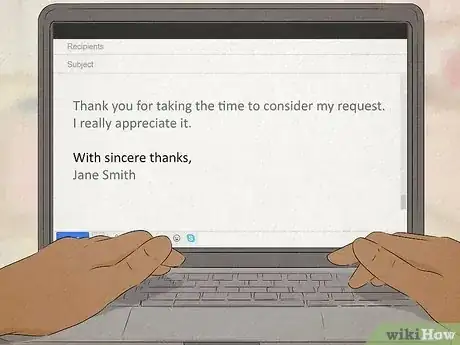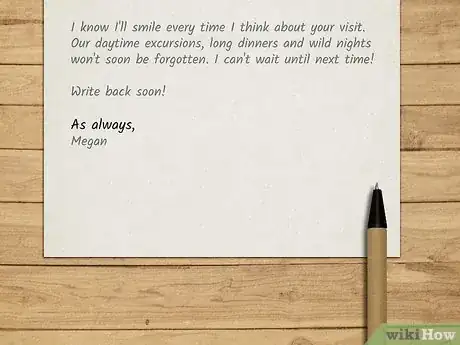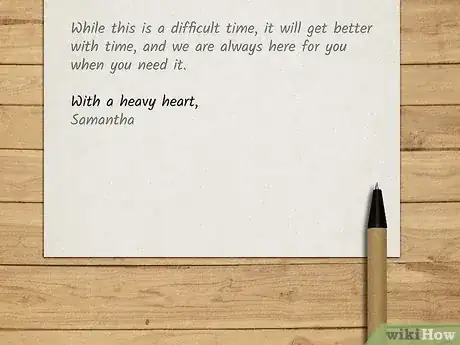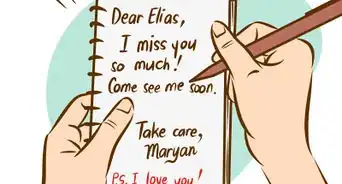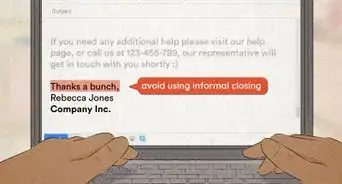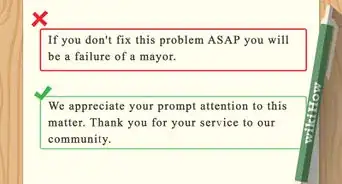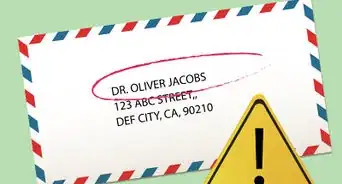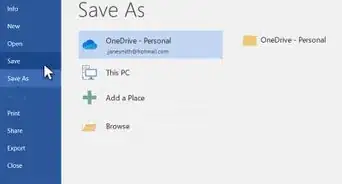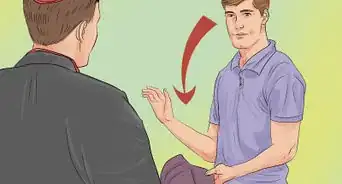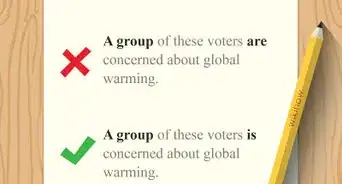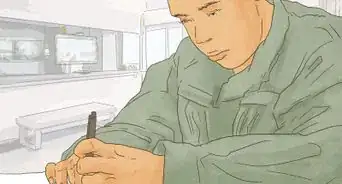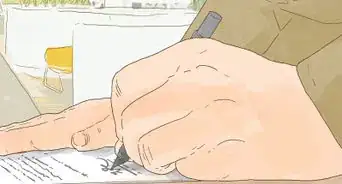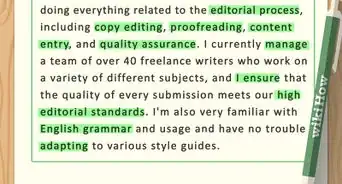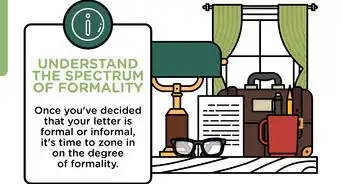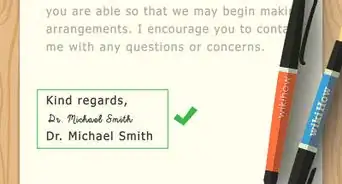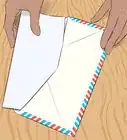This article was co-authored by wikiHow staff writer, Glenn Carreau. Glenn Carreau is a wikiHow Staff Writer, currently based in Los Angeles. With over four years of experience writing for several online publications, she has covered topics ranging from world history to the entertainment industry. Glenn graduated with honors from Columbia College Chicago, earning a B.A. in Interactive Arts and Media and a minor in Professional Writing. Today, Glenn continues to feed her lifelong love of learning while serving wikiHow's many readers.
This article has been viewed 226,826 times.
Learn more...
Are you feeling confused about how to choose a sincere, situation-appropriate closing phrase for your letter? You’re not alone! Whether you’re writing a business letter or a thank-you note, your closer is an important piece of the puzzle—and the right one often depends on the situation. Here, we’ll show you which closing phrases are most sincere and teach you how to choose the best one for your letter.
Things You Should Know
- Phrases like “Sincerely” and “Best” (along with variations like “Sincerely yours” and “Best wishes”) are great additions to any letter.
- Use professional closes like “Regards” and “Thank you for your time” to convey your message while being polite to people you don’t know well.
- Write more personal closes like “Take care,” “Cheers,” and “Your friend” in letters to people you know well and are friendly with.
Steps
Professional Closers
-
1“Sincerely” “Sincerely” works for any kind of letter, both professional and personal. When you’re trying to express sincerity, why not do so literally? “Sincerely” is a classic complementary close. The tone is formal enough for any professional correspondence while also conveying your sincerity to the reader (whoever they may be).[1] Variations of this close include:
- Sincerely
- Sincerely yours
- Very sincerely
- Very sincerely yours
-
2“Regards” Use distant but polite closes for new, important professional contacts. When you’re introducing yourself to a new contact or reaching out to a business associate you don’t know very well, it’s important to seem professional. “Regards” implies both sincerity and respect.[2] Use similar closes like:
- Cordially
- Respectfully
- Best regards
- “Regards” is a fairly neutral phrase. If you want to add some decorum without getting too friendly, “Best regards” is an easy switch.
Advertisement -
3“Kind regards” or “Yours truly” Closers like “Kind regards” strike a balance between formal and friendly. If you frequently speak with the recipient, be it a close colleague or friend, it’s okay to close letters with more familiarity. “Kind regards” is polite but friendlier in tone, while “Yours truly” communicates a sense of integrity with your letter.[3] Try other closes like,
- Kindest regards
- Warmly
- Warm(est) regards
- Have a good day/evening/weekend
- Take care
-
4“Hope to talk soon” “Hope to talk soon” encourages the reader to get back to you quickly. Use this closing phrase when you're sending a letter with the goal of getting a reply. It clarifies your intent while still sounding polite and indicating your sincere desire to talk to them.[4] Use variations like:
- Looking forward to your reply
- Hope to hear from you soon
- When writing to a friend, you could shorten the phrase and say, “Talk soon.”
-
5“Thank you for your time” Use “Thank you for your time” when asking for a professional favor. It’s polite and sincere because it thanks the reader for taking the time to read your message in the first place. Your correspondent will likely help you if you acknowledge their efforts! This also applies when you want to write letters of interest and cover letters.[5] Variations include:
- Thank you for your consideration
- Thank you for your recommendation
- Thank you in advance
- Thank you for your assistance
- Thank you (or “Thanks again” if you’ve already said it once near the beginning of the letter.)
-
6“With appreciation” “With appreciation” is a formal variation of a simple “thank you.” If you already used “thank you” in the body of your letter, or you want to find a different phrase to express your gratitude, use “With appreciation” to thank the reader for looking over the correspondence. It’s especially helpful when you want to write a cover letter and letters of interest.[6] You could also say:
- With gratitude
- Gratefully
- With sincere thanks
- Many thanks
-
7“Best” “Best” is polite yet not overly formal and an ideal default for most letters. Whether you’re writing a business inquiry or a quick note to a family member, “Best” is a great way to communicate your well-wishes to them politely. Use it as a default option, especially if you want a slightly more casual alternative to “Sincerely.”[7] Other versions include:
- Best wishes
- All the best
- Best of luck
Personal Closers
-
1“Love” or “Fondly” Affectionate closers convey sincerity to close friends and loved ones. There are some closes that should never be included in business correspondence—but are lovely and sincere inclusions in a letter to a close friend, partner, or family member.[8] In addition to “Love” and “Fondly,” those include:
- Your friend
- Cheers
- With love
- Always
- Hugs
- XOXO
-
2“As always” Use “As always” with friends and contacts you haven’t spoken to in a while. The phrase is polite and sincere; it indicates that you and your feelings are still the same. When you’re writing to a friend you don’t see often, it doesn’t hurt to remind them that you’re still you![9] You could also use “As ever” to close the letter instead.
-
3“With deepest sympathy” Use your close to express emotions when you write personal letters. A descriptive closer can remind a friend of your relationship and how you feel. End the letter by writing out the exact emotion you mean to express, whether it’s sympathy, sorrow, admiration, and so on. This kind of closer isn’t ideal for business correspondences, so save it for friends and family.[10]
- With heartfelt admiration
- With my most sincere apologies
- With a heavy heart
Formatting & Signature Tips
-
1Base your signature on how well you know the person you’re writing to. A signature is an important part of any handwritten letter and provides a feeling of authenticity to your words. Just be sure to consider who you’re writing to before signing your letter and sending it off![11]
- Sign your first and last name when you write to someone you’ve never met in person.
- Sign only your first name on letters to friends or work colleagues who know you.
- Write your last name in parentheses if you’ve spoken to the recipient on the phone but never met them in person.
-
2Use a handwritten or email format when sending professional letters. The formatting is simple enough: add a comma directly after your closing phrase, then leave 2 to 4 lines of space before leaving your signature. Then, in the lines below your signature, add any key information the recipient might need, like your email, job title, phone number, or work address.[12] Choose from the following formats:
- On a handwritten letter, include:
Sincerely,
Ashton Bailey (Signature)
Ashton Bailey (Your written name)
email@gmail.com (Your email)
555-555-5555 (Your phone number) - In an email, you only need your name, email address, company website, and logo (if there is one).
- On a handwritten letter, include:
Community Q&A
-
QuestionDoes my printed name go below my signature?
 Community AnswerYes, for more formal situations. When writing to a friend or a family member, though, it's not necessary.
Community AnswerYes, for more formal situations. When writing to a friend or a family member, though, it's not necessary. -
QuestionHow do I know when to use "sincerely"?
 Community AnswerYou can use "sincerely" anytime in a letter, as long if it's not for business.
Community AnswerYou can use "sincerely" anytime in a letter, as long if it's not for business. -
QuestionCan I send a letter to my ex with "with love?"
 Community AnswerIf you love them, you could do that.
Community AnswerIf you love them, you could do that.
References
- ↑ https://www.hunter.cuny.edu/rwc/repository/files/business-and-professional-writing/business_letter_handout-major-rev.pdf
- ↑ https://www.exclaimer.com/email-signature-handbook/email-sign-offs-guide/
- ↑ https://www.grammar-monster.com/lessons/yours_faithfully_or_sincerely_at_end_of_letter.htm
- ↑ https://www.exclaimer.com/email-signature-handbook/email-sign-offs-guide/
- ↑ https://www.exclaimer.com/email-signature-handbook/email-sign-offs-guide/
- ↑ https://www.exclaimer.com/email-signature-handbook/email-sign-offs-guide/
- ↑ https://erinwrightwriting.com/close-emails-letters-part-1/
- ↑ https://erinwrightwriting.com/close-emails-letters-part-1/
- ↑ https://www.theladders.com/career-advice/how-to-end-a-business-letter
- ↑ https://www.theladders.com/career-advice/how-to-end-a-business-letter
- ↑ https://owl.purdue.edu/owl/job_search_writing/job_search_letters/cover_letters_workshop/formatting_and_organization.html
- ↑ https://owl.purdue.edu/owl/job_search_writing/job_search_letters/cover_letters_workshop/formatting_and_organization.html
- ↑ https://www.hunter.cuny.edu/rwc/repository/files/business-and-professional-writing/business_letter_handout-major-rev.pdf


